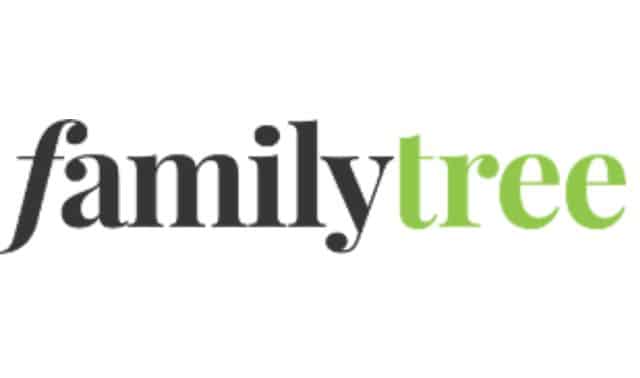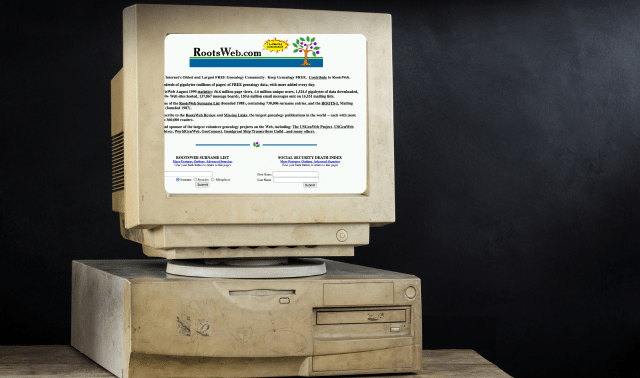Digital photography has changed our lives. As nostalgic as you might get for Kodachrome, waiting more than five seconds to see the image you just shot is utterly passé. Trekking to the drugstore to get film developed is as foreign a concept to Generation iPod as buying music at a bricks-and-mortar store. Though they probably wouldn’t know how to load a roll of film, those youngsters sure do have a handle on sharing photos online.
Whether they’re from Generation Y or the Greatest Generation, family historians have a responsibility to save photographic heirlooms both old and new. We take the time to scan delicate daguerreotypes, digitize 35mm prints stuffed in shoeboxes and download the latest family snaps to our computers. And we need to take precautions to make sure all that work isn’t in vain.
Any kid with a Facebook page knows that uploading pictures to a website is a good way to back up files and share them with family and friends. The ideal photo-sharing site will let you protect your photos with customizable privacy settings, save (and download) high-quality image files, and rest assured that the photos won’t be lost if your laptop bites the dust. We’ll take a look at four stellar photo-sharing sites—Flickr, Photobucket, Picasa Web Albums and Smugmug—to help you find the one with the right features for you and your pictures.
Photobucket
<www.photobucket.com>
<www.photobucket.com>
• Accounts: The Basic account is free; a Pro account is $24.95 a year.
• Storage limits: Free account includes 500MB of storage and 10GB of bandwidth per month; only web-resolution images are saved. Free accounts are deactivated after one year of inactivity. A Pro account has unlimited storage and bandwidth, and lets you save high-resolution images up to 20MB each. GIF, JPG, PNG and BMP file types are supported.
• Video capability: Upload videos of up to 10 minutes and 300MB in most formats; Photobucket converts them to FLV (Flash video) files.
• Printing: Photobucket offers prints, mugs, T-shirts, mouse pads and more through a partnership with Kodak; prints are available to pick up from your local Target.
• Uploading: On the home page, you can upload images from your computer or your family website. To post a lot of photos at once, use the site’s bulk uploader. You can upload images via mobile phone or e-mail by sending them to a unique address created automatically when you sign up for Photobucket.
• Organizing: When you upload photos, you must designate an album for them to go into. Adding descriptions and tags (up to 20 per image) helps make your image searchable.
• Sharing: Follow other Photobucket users whose photos you like; they’ll appear on your Following page. You can easily share photos and embed slideshows on social networking sites and blogging sites with widgets, accessible from every page. Give friends who aren’t on Photobucket access to your images with a guest password. Create a password for a private album by going to All Albums and hovering over album name and clicking Edit.
• Privacy: If your account is public, your images are visible to everyone. You can set your entire account to private, or make individual images or albums private. To make your account private, go to My Home>Account Settings and scroll down to Album Settings. Change the public option to private and click Save.
• Extras: Customize the way your albums look by choosing Themes. Create presentations to embed in other websites by clicking on the Slideshows tab in any Album. You can fix photos and add effects using the embedded FotoFlexer editing tool.
Flickr
<www.flickr.com>
<www.flickr.com>
• Accounts: A Basic account is free; a Pro account is $24.95 a year.
• Storage limits: With a free account, you can upload up to 100MB of photos (up to 10MB each) and two videos per month; only the 200 most recent items are visible in your Photostream. A Pro account offers unlimited storage space and photo (up to 20MB each) and video uploads. Photos and videos are never deleted. Flickr supports JPG, GIF and PNG files; TIFF files are converted to JPG.
• Video capability: Load videos up to 90 seconds and 150MB; accepts AVI, WMV, MOV, MPEG and 3PG formats
• Printing: Offers prints, photo books, cards, calendars and more through a partnership with Shutterfly.
• Uploading: Use the simple or Flash uploader tool on the website, download an app you can use to upload pictures, or send photos from your mobile phone to a special Flickr e-mail address.
• Organizing: Adding descriptive tags to your photos is a good way to sort your images and make them more searchable. The descriptions you add are searchable, too. You also can create Sets of photos based on a theme, such as “Robinson Family” or “Summer Vacation 2009.” You can group multiple sets together into Collections.
• Sharing: Even if the people you want to share photos with aren’t members of Flickr, you can give them access with an e-mailed guest pass. Send a guest pass by clicking on the Share This link at the top right of any page. Your friends on Flickr are called contacts, and you can mark them as friends or family. Groups let you share pictures based on topic; for example, the Old Photos group pool has almost 60,000 images.
• Privacy: Marking a photo or set as Public lets the whole world see it. If you make a photo private, only you can see it, or you can allow only contacts designated as friends or family to see it.
• Extras: Organizr lets you edit your photos in batches, which makes changing permissions, rotating images or sorting pics a snap. Picnik is a built-in photo editor akin to Photoshop Elements. By clicking the Edit Photo link above any image, you’re taken to the Picnik interface, where you can resize the image, adjust color and lighting, and fix red eye. Add notes to an image by clicking on the Add Note button or clicking on the image. Other Flickr users can add notes or people tags, too, making Flickr a great collaborative tool.
SmugMug
<www.smugmug.com>
<www.smugmug.com>
• Accounts: The Standard account is $39.95 a year; a Power account is $59.95 a year; a Pro account is $149.95 a year.
• Storage limits: Includes unlimited storage of JPG, GIF and PNG files; with pay-per-gigabyte SmugVault storage, you can upload RAW, TIFF, PDF and other files.
• Video capability: Power and Pro accounts can upload and share high-quality video.
• Printing: Smugmug sells prints starting at 19 cents, among other items; the site offers many other products through third-party vendors.
• Uploading: You can upload from your desktop , or with applications that work with photo programs such as iPhoto, Lightroom, Picasa and others. Upload by phone or e-mail by following the instructions at <www.smugmug.com/help/camera-phones>.
• Organizing: You upload photos into galleries, to which you can assign a name and category (including “genealogy”), NiceName (an easy-to-remember URL) and privacy level. You can add keywords to photos to make them searchable, and add a description. If you’re viewing a gallery in Arrange Mode, you can drag and drop photos into the order you want.
• Sharing: At the top of each page is a Share button; hover over it, and you’ll get a drop-down menu that will let you send an e-mail, give you links to post the image on a website, share the photo via Facebook or Twitter, and more.
• Privacy: Public galleries are visible to the whole world; unlisted ones are available to only those who know the URL. If you decide to Lock it Down, the photos will be protected with a password you choose.
• Extras: SmugMug has more editing tools and special effects than we have space to cover—learn all about them at <www.smugmug.com/help/photo-tools-menu>.
Picasa Web Albums
• Accounts: Your Picasa Web Albums account is associated with your free Google account; it integrates easily with free Picasa software.
• Storage limits: A free account includes 1GB of storage; you can buy more space starting at $5 a year for 20GB. Supported file formats include JPG, TIFF, BMP, GIF, PSD, PNG, TGA and some RAW formats.
• Video capability: Upload videos in most file formats up to 1GB with the Picasa application, or videos up to 100MB with the Mac Uploader application. Uploaded videos are converted to Flash (FLV) format.
• Printing: Order photo prints through Snapfish, Walgreens, Shutterfly and Photoworks.
• Uploading: Upload up to five individual files from your computer by clicking the button in the center of the top of any page. Or you can upload photos via Picasa software or with the iPhoto Exporter or Mac Uploader application. If you take photos on the go, you can activate the upload photos by e-mail option under Settings>General, which gives you a unique e-mail address to send pictures to after you enter a secret word of your choosing and save your changes.
• Organizing: You must specify an album for uploaded photos to go into. Add descriptive tags to further sort your images. Picasa uses face recognition technology for its name tags—once you label one person’s picture, the program will point out that person in all your other photos. Go to Settings>Privacy and Permissions, and click the button to allow name tags.
• Sharing: In any album, click Share to send an e-mail invitation to friends and family to view the album. You also have the option to invite them to add their own photos to the album. You can share photos on Facebook, Flickr or SmugMug with third-party plugins.
• Privacy: Limit access to individual albums by making them unlisted—so only people who know the exact URL will be able to see the photos—or by granting permission to people individually. This requires them to sign in with their Google account. Or you can make your photos public—this makes them searchable within Google Images and Picasa.
• Extras: You can sync Picasa on your computer to your Picasa Web Albums account, which makes backing up your files easy; click the Sync to Web button in Picasa to enable this feature. Mark where your photos were taken by geotagging them. Some cameras may automatically import this information, or you can drag a marker in the Google Map on a photo’s page.
Book ’Em
Facebook has become the leading photo-sharing site in the world. Members upload 2.5 billion photos every month—by comparison, users add about 90 million photos and videos each month to Flickr, the next biggest photo-sharing site. But when you upload pictures to Facebook, the images are resized for the web and become irretrievable in anything other than low resolution—no good for printing or archiving. If you just want to share some pics with your friends, that’s great. But if you’re trying to save high-res scans of heirloom photos, this is not the site to do it.
Facebook has become the leading photo-sharing site in the world. Members upload 2.5 billion photos every month—by comparison, users add about 90 million photos and videos each month to Flickr, the next biggest photo-sharing site. But when you upload pictures to Facebook, the images are resized for the web and become irretrievable in anything other than low resolution—no good for printing or archiving. If you just want to share some pics with your friends, that’s great. But if you’re trying to save high-res scans of heirloom photos, this is not the site to do it.
Uploader Beware
Though these sites’ flashy photo products and offers of free prints are attractive, we don’t recommend Snapfish, Shutterfly or Kodak Gallery for archiving your images. All three sites let you upload photos for free (and some brag of unlimited storage), but often you must meet minimum purchase requirements to keep your account active. If you don’t, your photos could be deleted.
Snapfish offers unlimited storage but requires that you make at least one purchase a year. If you don’t, your whole account could be deleted. Shutterfly offers unlimited storage and says photos will stay in your account unless you delete them yourself, but also points out that these terms are subject to change. With Kodak Gallery, you have to spend at least $4.99 a year on “qualifying products” if you store up to 2GB of photos, or $19.99 a year if you store more than that. Uploaded videos may be deleted after just 30 days.
Another consideration: You might be able to upload archival-quality, high-res images to these sites, but getting access to the originals could cost you. Often, these sites downsample the images for web display and charge you per image for high-quality downloads or archive CDs. Bottom line: Always read the terms of service (that long, boring legal document you pretend to read when signing up for a site) to determine what you’re getting yourself into.
More Online
Free Web Content
• Photo software tools <familytreemagazine.com/article/recent-developments-1>
• Glossary of computer file formats <familytreemagazine.com/article/glossary-of-computer-file-formats>
• Photo software tools <familytreemagazine.com/article/recent-developments-1>
• Glossary of computer file formats <familytreemagazine.com/article/glossary-of-computer-file-formats>
• Batch photo scanning services <familytreemagazine.com/batchscanning>
For Plus Members
• History of color photography
<familytreemagazine.com/article/true-colors>
• Read all of our photography articles
<familytreemagazine.com/articlelist/photography>
Family Tree Shop
• Photo Retouching: How to Bring Old Family Photos Back to Life webinar recording
<shopfamilytree.com/product/photo-retouching-webinar-download>
• Photo Sharing 101 live webinar
<shopfamilytree.com>
From the May 2010 Family Tree Magazine




